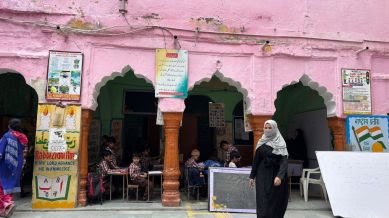Urdu-medium Municipal Corporation of Delhi (MCD) schools in Old Delhi’s Sita Ram Bazar are grappling with severe neglect, marked by crumbling infrastructure, dire staff shortages, and administrative apathy, reported the Hindustan Times.
In Bulbuli Khana, one such Urdu-medium MCD school paints a stark picture — dilapidated buildings with chipped paint, hanging wires, water seepage, and overcrowded classrooms. With only two small classrooms serving more than 100 students and a single teacher’s cabin, the school is ill-equipped to offer a safe or effective learning environment.
In the absence of a principal, one teacher and a special educator are compelled to juggle all responsibilities — from teaching every subject across nursery to Class 3, managing attendance and mid-day meals, to administrative duties. “I don’t even get paid for all of this,” lamented one of the teachers.
Another school in Lambi Gali suffers from a similar plight. Despite being an Urdu-medium school, it lacks permanent Urdu teachers. “The last recruitment drive was in 2016 — and that too for Hindi teachers,” a staff member revealed. These Hindi-speaking teachers are unable to teach Urdu, severely impacting student learning outcomes.
Parents expressed frustration over the confusion created by mismatched learning materials — Urdu textbooks paired with Hindi worksheets. “My son is in Class 3. He can neither read Urdu properly nor understand Hindi,” said a concerned mother.
With only seven teachers for 450 students, the school fails to meet the Right to Education (RTE) Act’s requirement of a 30:1 pupil-teacher ratio (PTR). Despite repeated demands, the MCD has not released vacancies or regularised temporary staff since 2010.
An MCD official admitted the PTR assessment is outdated and said student attendance till August 30 will be used for recalculating needs.
The staffing crisis is set to deepen — one of the two teachers is retiring next month, and the other is going on a six-month leave. “I ran this school alone during Covid-19. I don’t know who will teach the 105 children now,” said the school-in-charge.
Safety concerns also loom large. The school is housed in an old haveli with damaged roofs and leaking ceilings, some caused by washrooms of adjacent homes built above classrooms. A similar crisis is seen at Bhojla Pahari school, where a portion was declared unsafe years ago, but no repairs have been carried out.
Rafia Mahir, Aam Aadmi Party councillor of the area, raised these issues in the MCD’s standing committee meeting. She revealed that six out of the 11 Urdu-medium schools in her ward have been shut down due to a lack of teachers. “No student surveys have been done in the last 4-5 years. The authorities keep citing low enrollment and closing down schools,” she added.
Despite a budgetary allocation of Rs 1,693.7 crore — 9.83% of MCD’s total budget — for its 1,514 schools, and an additional Rs 2,234 crore grant from the Delhi government, the ground reality remains grim. Much of the funding goes toward salaries, textbooks, and uniforms, but basic infrastructure and staff requirements continue to be overlooked.
As Delhi’s Urdu-medium schools struggle for survival, students, teachers, and parents are left to question the government’s commitment to inclusive education.




